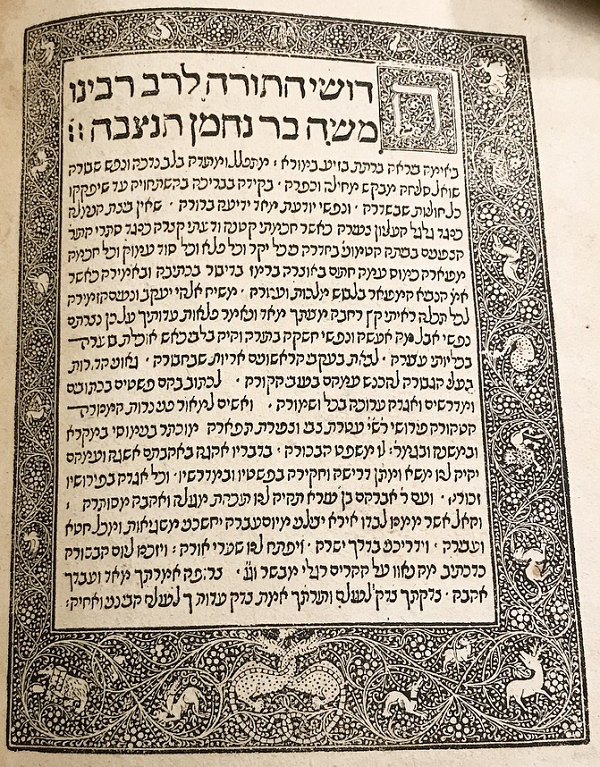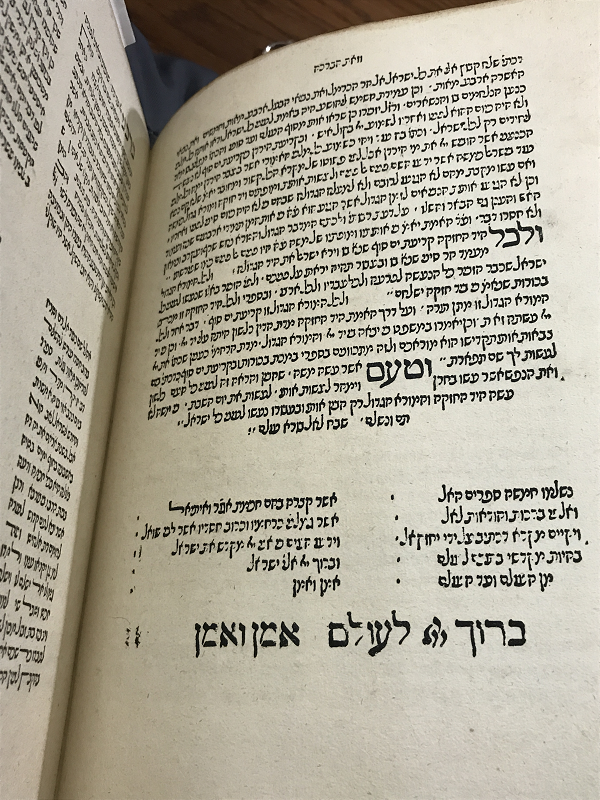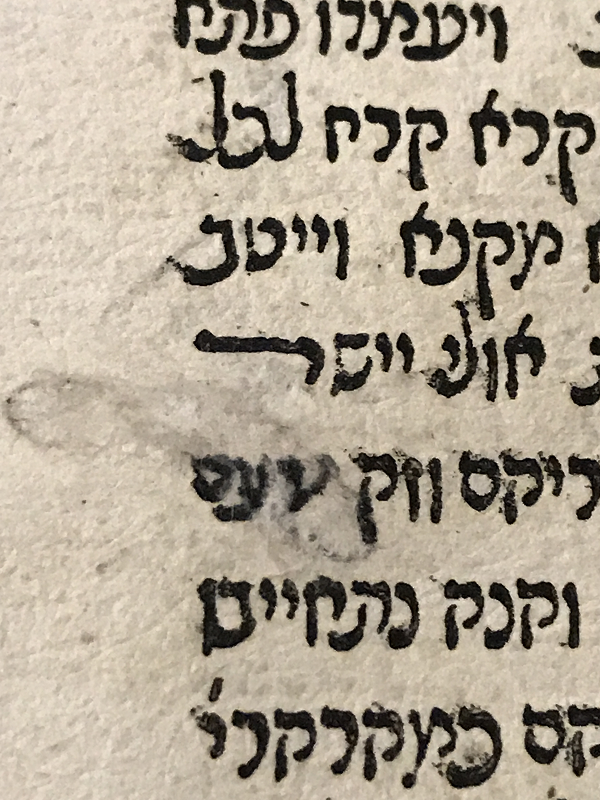
Nahmanides' Perush ha-Torah, Eliezer Toledano, Lisbon, 15 July 1489.
Title page begins: "Ḥidushe ha-Torah le-rav rabenu Mosheh bar Naḥman"
("New ideas on the Torah by the rabbi, our teacher, Moses ben Nahman").

Example of one of the more creative page layouts.

Example damage shown here has been mended with Japanese tissue paper and the eaten text provided in manuscript.
UCLA Library catalog describes the damages as "part of text destroyed (leaves [224-234] mended, text restored in ms.)"
Perush ha-Torah by Moses ben Nahman (aka Nahmanides), 1489
Housed in a nineteenth century full leather supported binding. Metal hardware is still extent at corners and fore-edge of the boards as latches for a clasp, though the strap itself no longer survives. The front and back boards display decorative tooling and stamping in a frame design with crisscross tooled lines through the center and decorative, Celtic style, knot patterns stamped around the lines. Double tooled lines surround the raised bands on the spine. Binding dates to the 19th century and is a vegetable tanned (indicated by the presence of extensive red rot) roan.1
The title page enclosed in metalcut border with thick contours and a simplified vine rinceaux type design, with the vines creating simplified roundels encircling animal figures both real and fantastic.2 The first page begins with similarly designed ornamental initials spelling the word sefer, which means book in Hebrew. The first word of the first chapter is printed in a larger typeface and used as a chapter heading, as is the case throughout the book though this initial chapter headings is given its own line, whereas future headings are given only a drop cap. Aside from this the text block is entirely unornamented, though there are some creative paragraph layouts. The layout is likely an imitation of manuscript layouts of the text as the printer would have been working off a manuscript copy, and also since textual organization was often copied with each iteration, a tradition trickled down from rabbinic laws which dictate the exact formating of the Torah.3 Certainly a solid block of text would be easier for a printer to set, especially a new one operating in the dawn of printing, than these slightly more creative layouts, so it is unlikely to be the printer’s invention.
The text block is relief printed on chain and laid paper with the chain lines running parallel to the spine. This, along with the large size of the page, is indicative of a folio format, which is confirmed by its record in the UCLA library catalog. A rather hungry bookworm has chewed two small holes through a sizeable chunk of the text block. In some places the holes have been repaired with Japanese tissue and the ingested letters infilled by hand. Some of the pages have also been remarginalized with a similar weight paper, with losses again provided in manuscript. The remarginalization is especially noticeable when the page is held up to light.
The metalcut border on the title page was initially created for “the Manuale Caesaraugustanum, probably produced by Fernandez de Cordoba in Valencia or Murcia” after which it was the first border used in in a Sephardic printed book in Hijar (Aragon) in the late 1480s by Eliezer ben Abraham Alantansi.4 Alantansi used the frame for two books after which it came into the hands of Eliezer ben Jacob Toledano (he moved to Lisbon from Toledo) which he used in his first two printed books: the one shown here, the Perush ha-Torah, and his second book the Perush Seder Tefillot.5
This book, the Perush ha-Torah as it is identified by its Incunabula Short Title Catalog uniform title, was not only the first Hebrew book printed in Lisbon, but in fact the first book printed in the city at all.6 Eliezer ben Jacob Toledano was active in the city between 1489 and 1492, the year the Jews were expulsed from Spain. Though initially given asylum by the Portuguese king (in return for payment), all the Jews in the country were declared slaves less than a year later.7 The edict was eventually overturned by King John’s successor, Manuel I, in 1494, but Manuel I then decreed two years later that all the Jews were to leave the country or convert by October 1497.8 Thus the printing career of Eliezer Toledano was ended less than a decade after it began. However, an apprentice in his shop, Don Judah Gedaliah, brought type with him to Salonica (Thessaloniki) in Greece when he left Lisbon, and set up his own printing shop in 1515.9 The shop ran for twenty years, continued by his children after his death in 1526.10 The frame from the title page continued to be used into the 16th century as well - it was used in another Jewish book printed in Constantinople in 1509.11
References:
Baemler, Johann, Gunther Zainer, Anton Zorg, Johann Schönsperger, Edward Ratdolt, Johann Zainer, Lienhart Holle, and Conrad Dinckmut. 2010. “Fifteenth Century - Heavenly Craft: The Woodcut in Early Printed Book | Exhibitions - Library of Congress.” Webpage. July 27, 2010. https://www.loc.gov/exhibits/heavenlycraft/heavenly-15th.html.
“Global Spread of the Printing Press.” 2018. Wikipedia. https://en.wikipedia.org/w/index.php?title=Global_spread_of_the_printing_press&oldid=827144178.
Landau, David, and Peter W. Parshall. 1994. The Renaissance Print, 1470-1550. Yale University Press.
“Manuale Secundum Ordinem Ecclesiae Caesaraugustanae.” n.d. Biblioteca Digital Hispánica. Accessed March 4, 2018. http://bdh-rd.bne.es/viewer.vm?id=0000177092&page=1.
Moses ben Nahman. 1489. “Perush ha-Torah.” Incunabula Short Title Catalogue (ISTC). July 16, 1489. http://data.cerl.org/istc/im00866160.
“MyWingsBooks - Laid Paper and Chain Lines.” n.d. Accessed March 4, 2018. http://www.mywingsbooks.com/coll-terms/pprlaid_.shtml.
“The First and Second Books Printed in Lisbon (July 16 – November 25, 1489): HistoryofInformation.Com.” n.d. Accessed March 4, 2018. http://www.historyofinformation.com/expanded.php?id=391.
“TOLEDANO - JewishEncyclopedia.Com.” n.d. Accessed March 4, 2018. http://www.jewishencyclopedia.com/articles/14434-toledano.
“Watermarks and Chain Lines on Different Formats | Incunabula - Dawn of Western Printing.” n.d. Accessed March 4, 2018. http://www.ndl.go.jp/incunabula/e/chapter3/ori_example1.html.
Notes
1 “UCLA Library Catalog Holdings Information.” n.d. Accessed February 27, 2018. https://catalog.library.ucla.edu/vwebv/holdingsInfo?searchId=9554&recCount=50&recPointer=0&bibId=2506555. ↩
2 “Important Judaica: 30. Sefer Abudraham [Perush Ha-Berakhot ve-Ha-Tefillot] (Commentary on Blessings and Prayers), David Ben Joseph Abudraham, Lisbon: [Eliezer Ben Judah Toledano], 1 Tevet 5250 (25 November 1489).” n.d. Sotheby’s. Accessed March 4, 2018. http://www.sothebys.com/en/auctions/ecatalogue/lot.30.html/2014/important-judaica-n09239. ↩
3 Stern, David. The Jewish Bible: A Material History. First edition. The Samuel & Althea Stroum Lectures in Jewish Studies. Seattle: University of Washington Press. 2017, p12. ↩
4 “Important Judaica: 30. Sefer Abudraham [Perush Ha-Berakhot ve-Ha-Tefillot] (Commentary on Blessings and Prayers), David Ben Joseph Abudraham, Lisbon: [Eliezer Ben Judah Toledano], 1 Tevet 5250 (25 November 1489).” n.d. Sotheby’s. Accessed March 4, 2018.http://www.sothebys.com/en/auctions/ecatalogue/lot.30.html/2014/important-judaica-n09239.↩
5 Heller, Marvin J. Further Studies in the Making of the Early Hebrew Book. The Brill Reference Library of Judaism 37. BRILL, 2013, p25-27.↩
6 “Lisbon’s First Book - Judaic Treasures.” n.d. Accessed March 4, 2018. http://www.jewishvirtuallibrary.org/lisbon-rsquo-s-first-book-judaic-treasures.
7 “History of the Jews in Portugal.” 2018. Wikipedia. https://en.wikipedia.org/w/index.php?title=History_of_the_Jews_in_Portugal&oldid=826636180.↩
8 “Persecution of Jews and Muslims by Manuel I of Portugal.” 2018. Wikipedia. https://en.wikipedia.org/w/index.php?title=Persecution_of_Jews_and_Muslims_by_Manuel_I_of_Portugal&oldid=824748557.↩
9 Heller, Marvin J. Further Studies in the Making of the Early Hebrew Book. The Brill Reference Library of Judaism 37. BRILL, 2013, p432.↩
10 “Gedaliah, (Don) Judah.” n.d. Accessed March 4, 2018. http://www.jewishvirtuallibrary.org/gedaliah-don-judah.↩
11 Heller, Marvin J. Further Studies in the Making of the Early Hebrew Book. The Brill Reference Library of Judaism 37. BRILL, 2013, p29.↩
This spotlight exhibit by Stephanie Geller as part of Dr. Johanna Drucker's "History of the Book and Literacy Technologies" seminar in Winter 2018 in the Information Studies Department at UCLA.
For documentation on this project, personnel, technical information, see Documentation. For contact email: drucker AT gseis.ucla.edu.